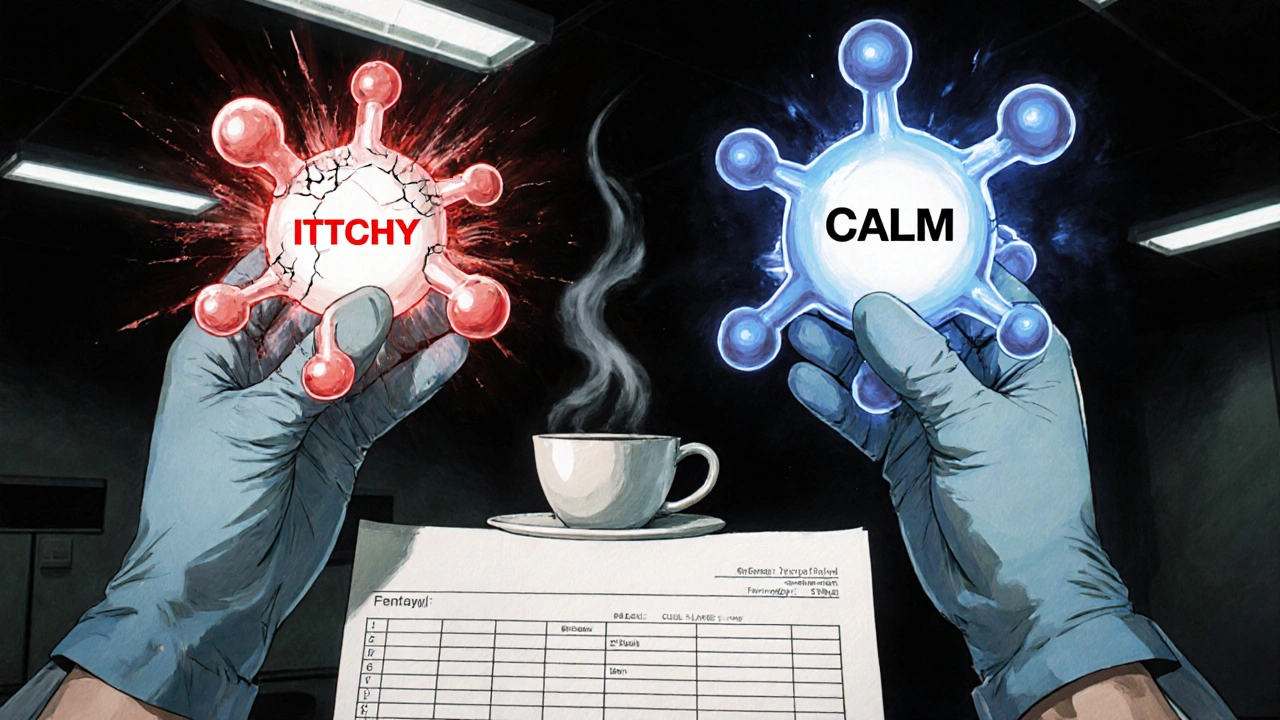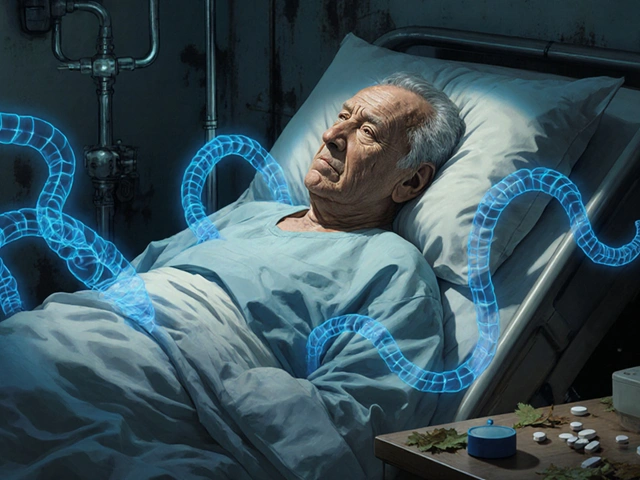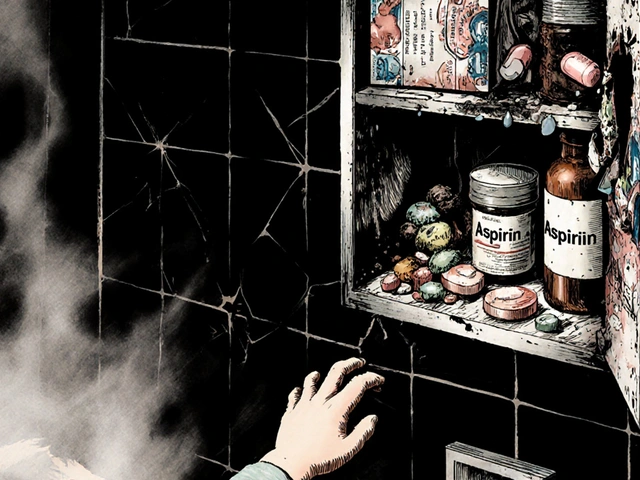Itching after taking an opioid like morphine doesn’t mean you’re allergic. In fact, it’s probably not an allergy at all. Around 80% of people who say they’re allergic to opioids are actually experiencing a side effect - not an immune reaction. This misunderstanding leads to worse pain control, more expensive drugs, and unnecessary fear. If you’ve ever felt itchy after an opioid injection or pill, you’re not alone. But knowing what’s really happening can change how you’re treated - and maybe even save you from being denied effective pain relief.
Itching Isn’t an Allergy - Here’s Why
When you get itchy after morphine or codeine, your body isn’t mounting an immune attack. Instead, the opioid is directly triggering mast cells in your skin to dump histamine. This is called a pseudoallergic reaction. It looks like an allergy - redness, flushing, itching - but no antibodies or immune memory are involved. You can’t become "sensitized" to it over time. It happens every time you get enough of the drug, and it gets worse with higher doses or faster IV pushes.
Studies show morphine releases 3 to 4 times more histamine than hydromorphone at the same pain-relieving dose. That’s why one person gets itchy on morphine but not on fentanyl or methadone. The chemical structure matters. Morphine and codeine have a specific shape that activates mast cells. Fentanyl, oxycodone, and methadone don’t. That’s why switching opioids often solves the problem without losing pain control.
What a Real Opioid Allergy Looks Like
True opioid allergies are rare - less than 0.3% of exposures. They involve the immune system recognizing the drug as a threat. Symptoms go beyond itching. You’ll see hives that raise above the skin, swelling of the lips or tongue (angioedema), trouble breathing, wheezing, or a sudden drop in blood pressure. These usually happen within minutes of taking the drug, especially the first time.
A 2022 Mayo Clinic case report described a woman who went into anaphylaxis five minutes after her first morphine dose. Her blood pressure crashed to 70 mmHg. She needed epinephrine and ICU care. That’s a true allergy. But if you just got itchy after your last shot and didn’t have swelling or breathing issues, you almost certainly don’t have one.
Why Mislabeling Matters
If you’re labeled "allergic to opioids," doctors avoid giving you any of them - even ones that won’t cause itching. That means you might get weaker painkillers like acetaminophen or NSAIDs, which don’t work well for severe pain. Or you might get more expensive alternatives like tramadol or tapentadol, which have their own risks.
Research shows mislabeling adds about $1,200 in extra costs per patient annually. In the U.S., with 200 million opioid prescriptions a year and 10-15% of people claiming allergies, this mistake affects 20 to 30 million people. That’s $24 to $36 billion wasted every year on unnecessary drug switches and extra testing.
Worse, many patients end up with uncontrolled pain. A 2021 Harvard study found that 78% of cancer patients with "opioid allergy" labels could safely take another opioid after pre-treating with an antihistamine. Only 5% had a true allergic reaction.

What to Do If You Get Itchy
Don’t assume you’re allergic. Don’t stop the medication unless you have swelling, breathing trouble, or dizziness. Talk to your provider. Here’s what works:
- Take an H1 antihistamine like diphenhydramine (Benadryl) 25-50 mg about 30 minutes before your next opioid dose. This blocks histamine and stops itching in 80-90% of cases.
- Ask your doctor to reduce the opioid dose by 25-50%. Lower doses mean less histamine release.
- If itching still happens, switch to an opioid with lower histamine-releasing potential. Fentanyl, methadone, or hydromorphone are good choices. Fentanyl is 100 times stronger than morphine, so dosing must be precise - but it rarely causes itching.
- Don’t use skin tests unless you had a life-threatening reaction. They’re often wrong and can give false positives in up to 30% of cases.
When to Switch Opioids
Not all opioids are the same. If you had itching on morphine, you’re not doomed to suffer. Here’s what works:
| Opioid | Class | Itching Risk | Notes |
|---|---|---|---|
| Morphine | Phenanthrene | High (30-40%) | Strong histamine releaser. Avoid if itching is the main issue. |
| Codeine | Phenanthrene | High (25-35%) | Often causes itching and nausea. Less effective for severe pain. |
| Fentanyl | Phenylpiperidine | Low (5-10%) | Very low histamine release. Great alternative. Requires careful dosing. |
| Methadone | Diphenylheptane | Low (5-10%) | Minimal itching. Long half-life (8-59 hours). Needs monitoring. |
| Oxycodone | Phenanthrene | Medium (15-25%) | Less histamine than morphine but still causes itching in some. |
| Hydromorphone | Phenanthrene | Low (10-15%) | 4x stronger than morphine. Less itching than morphine at equivalent doses. |
Switching from morphine to fentanyl or methadone reduces itching from 30-40% down to 5-10%. This isn’t guesswork - it’s chemistry. The tertiary amine group in morphine triggers mast cells. Fentanyl and methadone lack that structure. That’s why they’re safer for people who itch.

What About New Treatments?
There’s exciting progress. A drug called nalfurafine, approved in Japan since 2009 and in Phase 3 trials in the U.S., targets the brain’s itch pathway directly. Unlike antihistamines, it doesn’t block histamine - it blocks the spinal cord receptors (GRPR) that cause opioid-induced itching. A 2023 study showed it cuts itching by 70% without reducing pain relief.
Researchers are also looking at genetic markers. Some people have a variation in the HTR7 gene that makes them more likely to release histamine when given morphine. In the future, a simple blood test might tell you if you’re at high risk before you even take the drug.
And new opioids are being designed to avoid histamine release entirely. Two candidates - CR845 and NOP receptor agonists - are in late-stage trials. Early results show an 80% drop in itching without losing pain control.
What Patients Are Saying
On Reddit’s r/painmanagement, users share real experiences:
- "I was told I was allergic to all opioids because I got itchy on morphine. I tried fentanyl patch with Benadryl - no itching, no problem. Now I’m not in pain anymore." - u/PainWarrior2022
- "My doctor refused to give me anything stronger than Tylenol because I "got itchy." I finally switched to hydromorphone and it worked perfectly. Why didn’t they just try that first?" - u/ChronicPainSurvivor
But not all stories are easy. One patient described a true allergic reaction: "I broke out in hives, my throat closed, and I couldn’t breathe. I had to be rushed to the ER. That’s not side effects - that’s an allergy." That’s real. And it’s rare.
Bottom Line: Don’t Panic, But Don’t Ignore It
If you get itchy after an opioid, don’t assume you’re allergic. Don’t refuse future doses. Don’t let a label keep you from pain relief. Talk to your doctor. Ask if you can try:
- Antihistamine before the next dose
- A lower dose
- A different opioid - fentanyl, methadone, or hydromorphone
True allergies are serious. But itching? That’s usually just a side effect - and one that’s easy to fix.
For patients with chronic pain, this isn’t just about comfort. It’s about function. It’s about being able to sleep, move, and live. Getting the right opioid matters. And knowing the difference between itching and allergy can change your life.
Is itching after morphine a sign of an opioid allergy?
No, itching after morphine is not a true allergy. It’s a pseudoallergic reaction caused by histamine release from mast cells. This happens in 30-40% of people taking morphine and doesn’t involve the immune system. True allergies involve swelling, breathing trouble, or low blood pressure.
Can I still take opioids if I get itchy?
Yes. You can usually take other opioids safely. Switching to fentanyl, methadone, or hydromorphone often eliminates itching. Adding an antihistamine like diphenhydramine before your dose also works in 80-90% of cases. You don’t have to avoid all opioids just because one causes itching.
Should I get skin tested for an opioid allergy?
Only if you had a life-threatening reaction like anaphylaxis. Skin tests for opioids are unreliable and give false positives in up to 30% of cases. Most guidelines, including those from the American Pain Society, recommend against routine testing. A therapeutic trial with a different opioid is safer and more accurate.
Why do some opioids cause itching and others don’t?
It depends on their chemical structure. Morphine and codeine have a specific group (tertiary amine) that triggers mast cells to release histamine. Fentanyl, methadone, and hydromorphone lack this structure, so they don’t cause itching as often. That’s why switching opioids often solves the problem.
What’s the best way to treat opioid-induced itching?
Start with an H1 antihistamine like diphenhydramine (25-50 mg) taken 30 minutes before the opioid. Reduce the opioid dose by 25-50% if possible. If itching continues, switch to an opioid with low histamine release - fentanyl or methadone are top choices. Avoid using steroids or epinephrine unless you have signs of a true allergic reaction.
Can I become allergic to opioids over time?
No, you can’t become allergic to opioids through repeated use if you’re only experiencing itching. True allergies require immune system involvement and usually happen on first exposure. Pseudoallergic reactions like itching happen every time you take enough of the drug - but they’re not immune-based. If you’ve been itchy on morphine for years, you’re not becoming allergic - you’re just getting the same side effect.
What should I tell my doctor if I think I’m allergic to opioids?
Be specific. Say: "I get itchy after morphine, but I’ve never had swelling, trouble breathing, or low blood pressure." Ask if you can try a different opioid like fentanyl or methadone with an antihistamine. Avoid saying "I’m allergic to all opioids." That label is often wrong and limits your treatment options.





